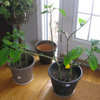The Leichhardtii Paradox
bismuth
17 years ago
More Discussions
In Australia, there exist two subspecies of Datura leichhardtii: D. leichhardtii ssp. leichhardtii and D. leichhardtii ssp. pruinosa. The species leichhardtii has small flowers which open only occasionally. This species my have originated in Mexico and surrounding areas, though the precise origin is not of the essence. What is important is that Datura leichhardtii is alien to Australia. If two subspecies originated from the same plant, which self-pollinates and hardly exposes its stigma nor its anthers, then how is it possible that ssp. pruinosa and ssp. leichhardtii can be two different plants? If self-pollination produces an identical plant, is the difference between the two merely superficial, a condition brought on by a slight change in soil chemistry and moisture? Is that not the same as saying that one carrot is separated on the subspecies level from another carrot, just because it has been fertilized and given a little more water? I understand that mutations do occur, and Datura leichhardtii needs only open its flowers once to accept new biological information, but I would like to hear some words on this from a knowledged person.

gardengrove_ac
bismuthOriginal Author